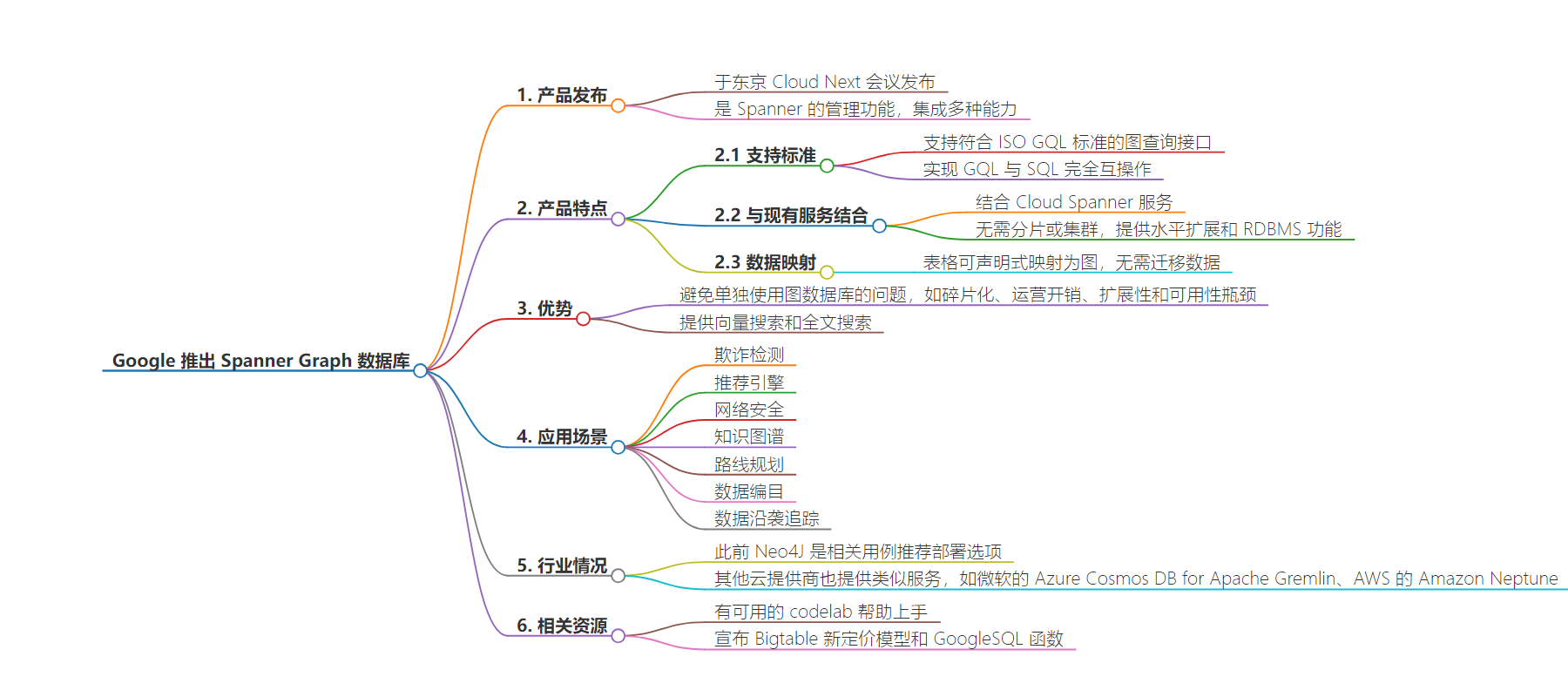包阅导读总结
1.
– `Spanner Graph`、`Google`、`Graph Database`、`Cloud Spanner`、`Data Silos`
2.
在东京的 Cloud Next 会议上,Google 推出 Spanner Graph,它整合了多种能力于 Spanner 中,支持与 ISO 兼容的图查询接口,无需单独的图数据库,能实现 GQL 和 SQL 完全互操作,还提供了向量和全文搜索,有多种适用场景,现已有相关 codelab 可用。
3.
– Spanner Graph 发布
– 在东京 Cloud Next 会议上宣布
– 集成多种能力于 Spanner
– 特点与优势
– 支持 ISO GQL 标准的图查询接口
– 与 Cloud Spanner 结合,无需单独数据库
– 实现 GQL 与 SQL 完全互操作
– 避免数据孤岛,无需迁移或转换数据
– 功能与能力
– 提供向量搜索和全文搜索
– 适用多种场景,如欺诈检测等
– 与其他产品对比
– 区别于之前推荐的 Neo4J
– 相比其他云提供商的同类产品有自身特点
– 相关资源
– 已有 codelab 可用
– 还宣布了 Bigtable 的新定价模型和 GoogleSQL 函数
思维导图:
文章来源:infoq.com
作者:Renato Losio
发布时间:2024/8/24 0:00
语言:英文
总字数:579字
预计阅读时间:3分钟
评分:92分
标签:图数据库,Google Cloud Spanner,GQL,ISO GQL,SQL
以下为原文内容
本内容来源于用户推荐转载,旨在分享知识与观点,如有侵权请联系删除 联系邮箱 media@ilingban.com
At the recent Cloud Next conference in Tokyo, Google announced Spanner Graph, a managed feature that integrates graph, relational, search, and AI capabilities within Spanner. This new database supports a graph query interface compatible with ISO GQL (Graph Query Language) standards while avoiding the need for a standalone graph database.
Spanner Graph now combines graph database capabilities with Cloud Spanner, Google Cloud’s globally distributed and scalable database service that provides horizontal scaling and RDBMS features without the need for sharding or clustering. One of the goals of the project is the full interoperability between GQL and SQL to break down data silos and lets developers choose the tool for the specific use case, without extracting or transforming data. Bei Li, senior staff software engineer at Google, and Chris Taylor, Google fellow, explain:
Tables can be declaratively mapped to graphs without migrating the data, which brings the power of graph to tabular datasets. With this capability, you can late-bind (i.e., postpone) data model choices and use the best query language for each job to be done.
While graphs provide a natural mechanism for representing relationships in data, Google suggests that adopting standalone graph databases leads to fragmentation, operational overhead, and scalability and availability bottlenecks, especially since organizations have substantial investments in SQL expertise and infrastructure. Taylor comments on LinkedIn:
Interconnected data is everywhere, and graph query languages are a fantastic way to understand and gain value from it. With Spanner Graph, you can have the expressive power and performance of native graph queries, backed by the reliability and scale of Spanner.
A highly anticipated feature in the community, Spanner Graph offers vector search and full-text search, allowing developers to traverse relationships within graph structures using GQL while leveraging search to find graph content. Li and Taylor add:
You can leverage vector search to discover nodes or edges based on semantic meaning, or use full-text search to pinpoint nodes or edges that contain specific keywords. From these starting points, you can then seamlessly explore the rest of the graph using GQL. By integrating these complementary techniques, this unified capability lets you uncover hidden connections, patterns, and insights that would be difficult to discover using any single method.
Among the use cases suggested for the new Spanner Graph, the cloud provider highlights fraud detection, recommendation engines, network security, knowledge graphs, route planning, data cataloging, and data lineage tracing. Eric Zhang, software engineer at Modal, comments:
Google’s new Spanner Graph DB looks pretty awesome and hints at a world where multi-model databases are the norm.
Rick Greenwald, independent industry analyst, adds:
By having graph, as well as structured data, search operations and vector operations all accessible within the same SQL interface, Spanner essentially removes the need for users to understand what database technology they need and implement it before they can get started solving problems. The range of options to derive value from your data expands, without undue overhead.
Previously, Neo4J was the recommended deployment option on Google Cloud for many use cases now covered by Spanner Graph. Google is not the only cloud provider offering a managed graph database: Microsoft offers Azure Cosmos DB for Apache Gremlin, while AWS introduced Amazon Neptune years ago, a service distinct from NoSQL Amazon DynamoDB, which was previously recommended for similar scenarios.
A codelab is now available to get started with Spanner Graph. During the conference, Google also announced new pricing models and GoogleSQL functions for Bigtable, the NoSQL database for unstructured data, and latency-sensitive workloads.
